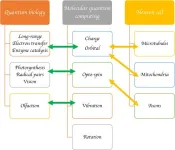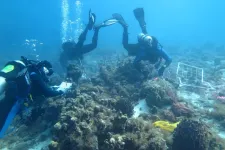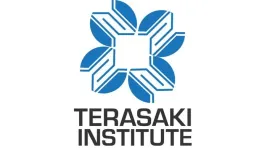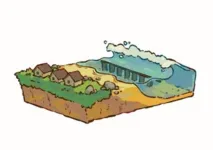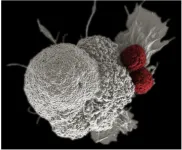(Press-News.org) An international research team led by RMIT University has designed and manufactured a virus-killing surface that could help control disease spread in hospitals, labs and other high-risk environments.
The surface made of silicon is covered in tiny nanospikes that skewer viruses on contact.
Lab tests with the hPIV-3 virus – which causes bronchitis, pneumonia and croup – showed 96% of the viruses were either ripped apart or damaged to the point where they could no longer replicate to cause infection.
These impressive results, featured on the cover of top nanoscience journal ACS Nano, show the material’s promise for helping control the transmission of potentially dangerous biological material in laboratories and healthcare environments.
Spike the viruses to kill them
Corresponding author Dr Natalie Borg, from RMIT’s School of Health and Biomedical Sciences, said this seemingly unsophisticated concept of skewering the virus required considerable technical expertise.
“Our virus-killing surface looks like a flat black mirror to the naked eye but actually has tiny spikes designed specifically to kill viruses,” she said.
“This material can be incorporated into commonly touched devices and surfaces to prevent viral spread and reduce the use of disinfectants.”
The nano spiked surfaces were manufactured at the Melbourne Centre for Nanofabrication, starting with a smooth silicon wafer, which is bombarded with ions to strategically remove material.
The result is a surface full of needles that are 2 nanometers thick – 30,000 times thinner than a human hair – and 290 nanometers high.
Specialists in antimicrobial surfaces
The team led by RMIT Distinguished Professor Elena Ivanova has years of experience studying mechanical methods for controlling pathogenic microorganisms inspired by the world of nature: the wings of insects such as dragonflies or cicadas have a nanoscale spiked structure that can pierce bacteria and fungi.
In this case, however, viruses are an order of magnitude smaller than bacteria so the needles must be correspondingly smaller if they are to have any effect on them.
The process by which viruses lose their infectious ability when they contact the nanostructured surface was analysed in theoretical and practical terms by the research team.
Researchers at Spain’s Universitat Rovira i Virgili (URV), Dr Vladimir Baulin and Dr Vassil Tzanov, computer simulated the interactions between the viruses and the needles.
RMIT researchers carried out a practical experimental analysis, exposing the virus to the nanostructured surface and observing the results at RMIT’s Microscopy and Microanalysis Facility.
The findings show the spike design to be extremely effective at damaging the virus’ external structure and piercing its membranes, incapacitating 96% of viruses that came into contact with the surface within six hours.
Study first author, Samson Mah, who completed the work under an RMIT-CSIRO Masters by Research Scholarship and has now progressed to working on his PhD research with the team, said he was inspired by the practical potential of the research.
“Implementing this cutting-edge technology in high-risk environments like laboratories or healthcare facilities, where exposure to hazardous biological materials is a concern, could significantly bolster containment measures against infectious diseases,” he said.
“By doing so, we aim to create safer environments for researchers, healthcare professionals, and patients alike.”
The project was a truly interdisciplinary and multi-institutional collaboration carried out over two years, involving researchers from RMIT, URV (Spain), CSIRO, Swinburne University, Monash University and the Kaiteki Institute (Japan).
This study was supported by the ARC Research Hub for Australian Steel Manufacturing and by the ARC Industrial Transformational Training Centre in Surface Engineering for Advanced Materials.
‘Piercing of the Human Parainfluenza Virus by Nanostructured Surfaces’ is published in ACS Nano. (DOI: 10.1021/acsnano.3c07099)
END
Silicon spikes take out 96% of virus particles
An international research team led by RMIT University has designed and manufactured a virus-killing surface that could help control disease spread in hospitals, labs and other high-risk environments.
2024-03-26
ELSE PRESS RELEASES FROM THIS DATE:
New research area promotes both quantum computing and cognitive science
2024-03-26
Diving deep into quantum biology or cognitive science alone is challenging enough. That being said, a research team recently wrote a review article highlighting molecular quantum computing, a newly emerged research area that is likely to push the research boundaries of both. The review was published Feb. 21 in Intelligent Computing, a Science Partner Journal.
Future theoretical breakthroughs may be achieved by connecting molecular quantum computing, the bridge research area, with cognitive science and quantum ...
Among deaf people, women have higher levels of personal growth
2024-03-26
One of the features of the deaf community is that it is highly diverse. As well as including people of different ages and genders, the members of the community do not all share the same type of deafness or form of communication. Firstly, the time of onset of deafness and the degree of hearing loss vary greatly. And secondly, not everybody uses sign and oral language in the same way. All these aspects have a bearing on the well-being of deaf people. However, few studies specifically analyse the effect of each one.
The PhD thesis, defended by Amaia Jauregi-Orbe at the Faculty ...
Severe hurricanes boost influx of juveniles and gene flow in a coral reef sponge
2024-03-26
Named for its ropy-looking long branches, Aplysina cauliformis, a coral reef sponge, provides a critical 3D habitat for marine organisms and helps to stabilize the foundation of coral reefs. However, these upright branching sponges are highly susceptible to breaking during storms, which increases sponge fragmentation and contributes to population clonality and inbreeding.
Many sponges can survive severe damage and undergo frequent fragmentation, which is considered a mechanism for asexual reproduction. While fragmentation is a commonly utilized reproductive strategy in rope sponges, they also can reproduce sexually by producing larvae. How and whether they recolonize following ...
Terasaki Institute for Biomedical Innovation catalyzes healthcare revolution with launch of four cutting-edge startups
2024-03-26
LOS ANGELES – (3/26/24) - In a landmark move for biomedical progress, the Terasaki Institute for Biomedical Innovation (TIBI) today unveiled the launch of four pioneering startup companies. These ventures represent a strategic leap forward in TIBI's commitment to transforming healthcare through innovation. By harnessing the institute's groundbreaking research in biomaterials, micro-needles, organoids, tissue engineering, and advanced biosensing, these startups are poised to tackle some of the most pressing health challenges ...
Faux reefs for coastal protection
2024-03-26
Engineers have designed a modular artificial reef that can dissipate wave energy far better than natural coral reefs, according to a study. Sixty percent of the world’s coral reefs are under threat from rising ocean temperatures, overfishing, or coastal development. At the same time, climate change is leading to sea level rise, frequent high-tide flooding, and powerful storm surges. Artificial reefs can help protect coastal infrastructure from storms as well as provide habitat for marine organisms. Michael Triantafyllou and colleagues proposed and tested an architected cellular reef structure ...
Mount Sinai study calls for major changes in the way people with comorbidities are selected by physicians for lung cancer screening
2024-03-26
A Medicare policy requiring primary care providers (PCPs) to share in the decision-making with patients on whether to proceed with lung cancer screening is fraught with confusion and lack of evidence-based information, and may actually be undermining the purpose for which it was created, Mount Sinai researchers say.
In their study, published in Annals of Family Medicine, the team reported that the policy, enacted nearly 10 years ago to encourage the use of lung cancer screening, is in urgent need of new ...
Smart maneuver: Epstein-Barr virus hijacks host genome boosting nasopharyngeal carcinoma
2024-03-26
Nasopharyngeal carcinoma (or NPC) is a rare type of cancer affecting the epithelial tissue of the nasopharynx, the upper part of the throat behind the nasal cavity. Among the three main subtypes of NPC, non-keratinizing undifferentiated squamous carcinoma is endemic to the regions of Southern China and Southeast Asia, with a strong association with Epstein-Barr virus (or EBV) infection. EBV, also known as human tumor virus, is a double-stranded DNA virus that is associated with various cancers, such as Burkitt lymphoma, T-cell lymphoma, and gastric cancer. EBV genomes mostly survive autonomously as episomes or extrachromosomal ...
New method to measure entropy production on the nanoscale
2024-03-26
Entropy, the amount of molecular disorder, is produced in several systems but cannot be measured directly. An equation developed by researchers at Chalmers University of Technology and Heinrich Heine University Düsseldorf, now sheds new light on how entropy is produced on a very short time scale in laser excited materials.
“New computational models give us new research opportunities. Extending thermodynamics for ultrashort excitations will provide novel insights into how materials function on the nanoscale,” says Matthias Geilhufe, Assistant Professor ...
Scientists on the hunt for evidence of quantum gravity’s existence at the South Pole
2024-03-26
Scientists on the hunt for evidence of quantum gravity’s existence at the South Pole
University of Copenhagen team contributes to an Antarctic large-scale experiment striving to find out if gravity also exists at the quantum level. An extraordinary particle able to travel undisturbed through space seems to hold the answer.
Several thousand sensors distributed over a square kilometer near the South Pole are tasked with answering one of the large outstanding questions in physics: does quantum gravity exist? ...
New roadmap to prevent pandemics centers on protecting biodiversity
2024-03-26
ITHACA, N.Y. – An international team of 25 scientists has proposed a roadmap for how to prevent the next pandemic by conserving natural areas and promoting biodiversity, thereby providing animals with enough food, safe havens and distance to limit contact and the transfer of pathogens to humans.
Pandemics begin when disease-harboring animals, such as bats, come in close proximity with people, livestock or other animals and pass on new pathogens. Viruses such as SARS-CoV-2, SARS-CoV-1, Nipah, Hendra and possibly Ebola have all fatally spilled over from bats to humans, ...
LAST 30 PRESS RELEASES:
Injectable breast ‘implant’ offers alternative to traditional surgeries
Neuroscientists devise formulas to measure multilingualism
New prostate cancer trial seeks to reduce toxicity without sacrificing efficacy
Geometry shapes life
A CRISPR screen reveals many previously unrecognized genes required for brain development and a new neurodevelopmental disorder
Hot flush treatment has anti-breast cancer activity, study finds
Securing AI systems against growing cybersecurity threats
Longest observation of an active solar region
Why nail-biting, procrastination and other self-sabotaging behaviors are rooted in survival instincts
Regional variations in mechanical properties of porcine leptomeninges
Artificial empathy in therapy and healthcare: advancements in interpersonal interaction technologies
Why some brains switch gears more efficiently than others
UVA’s Jundong Li wins ICDM’S 2025 Tao Li Award for data mining, machine learning
UVA’s low-power, high-performance computer power player Mircea Stan earns National Academy of Inventors fellowship
Not playing by the rules: USU researcher explores filamentous algae dynamics in rivers
Do our body clocks influence our risk of dementia?
Anthropologists offer new evidence of bipedalism in long-debated fossil discovery
Safer receipt paper from wood
Dosage-sensitive genes suggest no whole-genome duplications in ancestral angiosperm
First ancient human herpesvirus genomes document their deep history with humans
Why Some Bacteria Survive Antibiotics and How to Stop Them - New study reveals that bacteria can survive antibiotic treatment through two fundamentally different “shutdown modes”
UCLA study links scar healing to dangerous placenta condition
CHANGE-seq-BE finds off-target changes in the genome from base editors
The Journal of Nuclear Medicine Ahead-of-Print Tip Sheet: January 2, 2026
Delayed or absent first dose of measles, mumps, and rubella vaccination
Trends in US preterm birth rates by household income and race and ethnicity
Study identifies potential biomarker linked to progression and brain inflammation in multiple sclerosis
Many mothers in Norway do not show up for postnatal check-ups
Researchers want to find out why quick clay is so unstable
Superradiant spins show teamwork at the quantum scale
[Press-News.org] Silicon spikes take out 96% of virus particlesAn international research team led by RMIT University has designed and manufactured a virus-killing surface that could help control disease spread in hospitals, labs and other high-risk environments.
